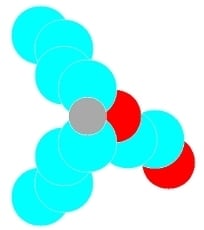Organotin Polyethers as Biomaterials
Abstract
:1. Introduction
1.1. Organotins
1.2. Organotin Polyethers

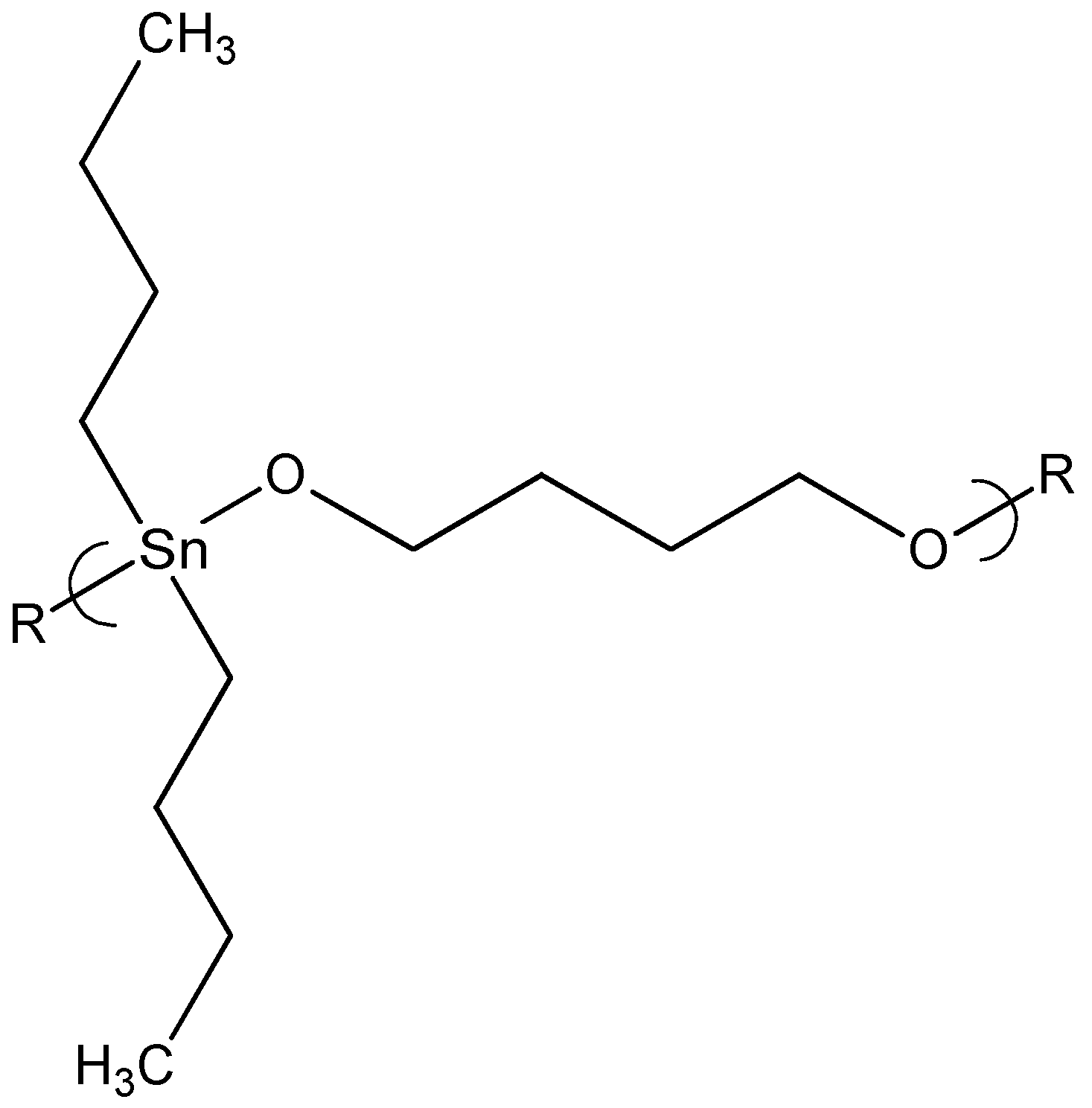
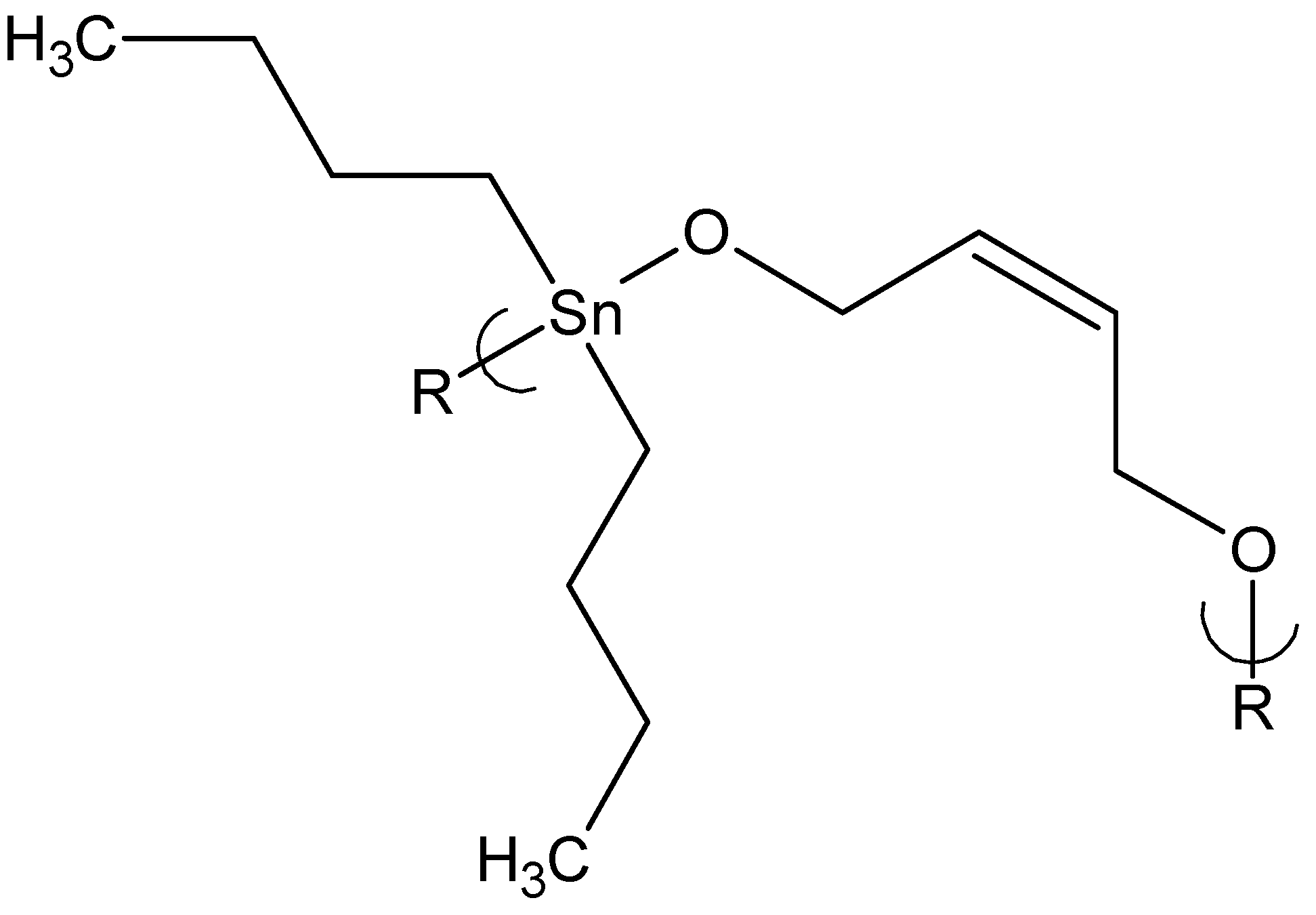
2. Results and Discussion
2.1. Biological Activities
2.2. General
2.3. Organotin Compounds and Their Anticancer Activity
2.3.1. Mechanism of Action of Organotin Compounds
2.3.2. Polymeric Drugs-Advantages
2.3.3. Solubility
2.3.4. Stability
2.3.5. Physical Nature
2.3.6. Thermal Properties
2.3.7. Mass Spectrometry
2.4. Biological Activities of Polysaccharides
2.5. General Properties and Cancer Inhibition of Organotin Polyethers
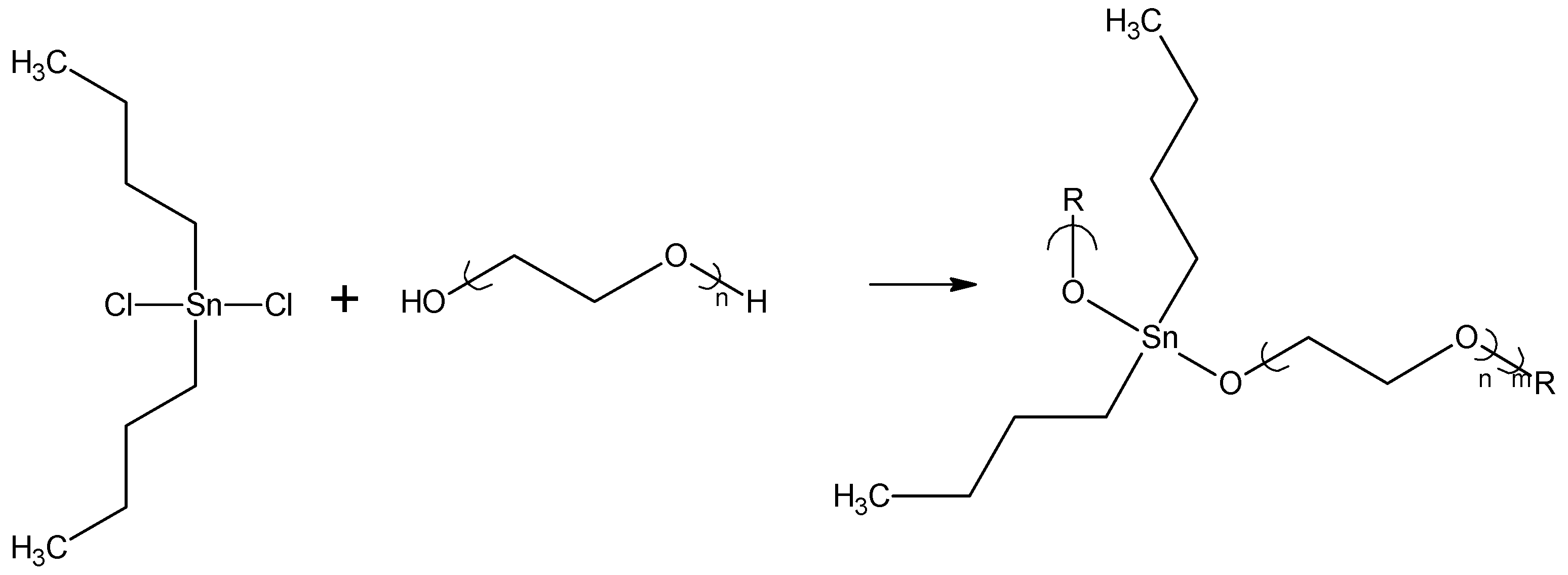
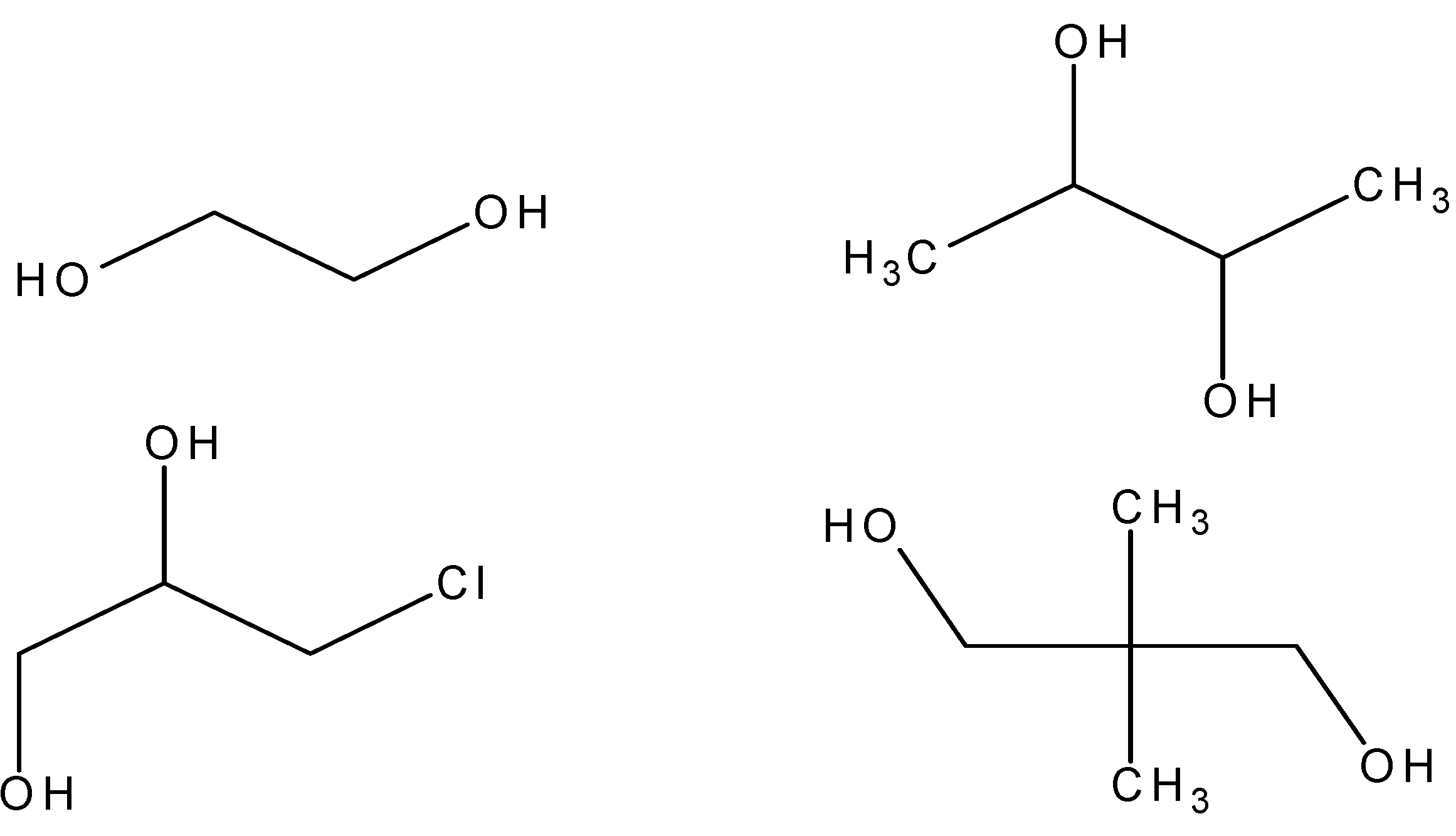
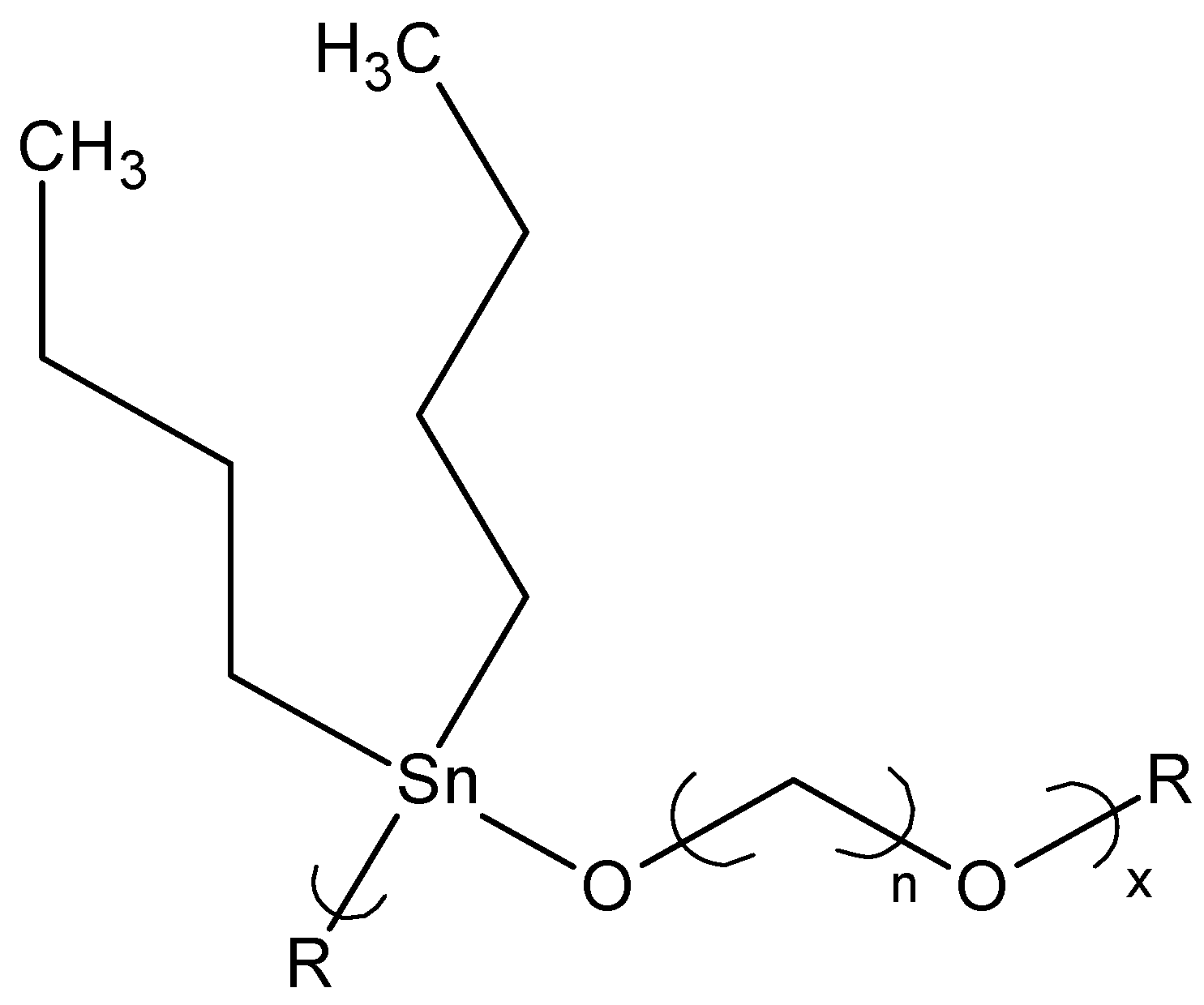

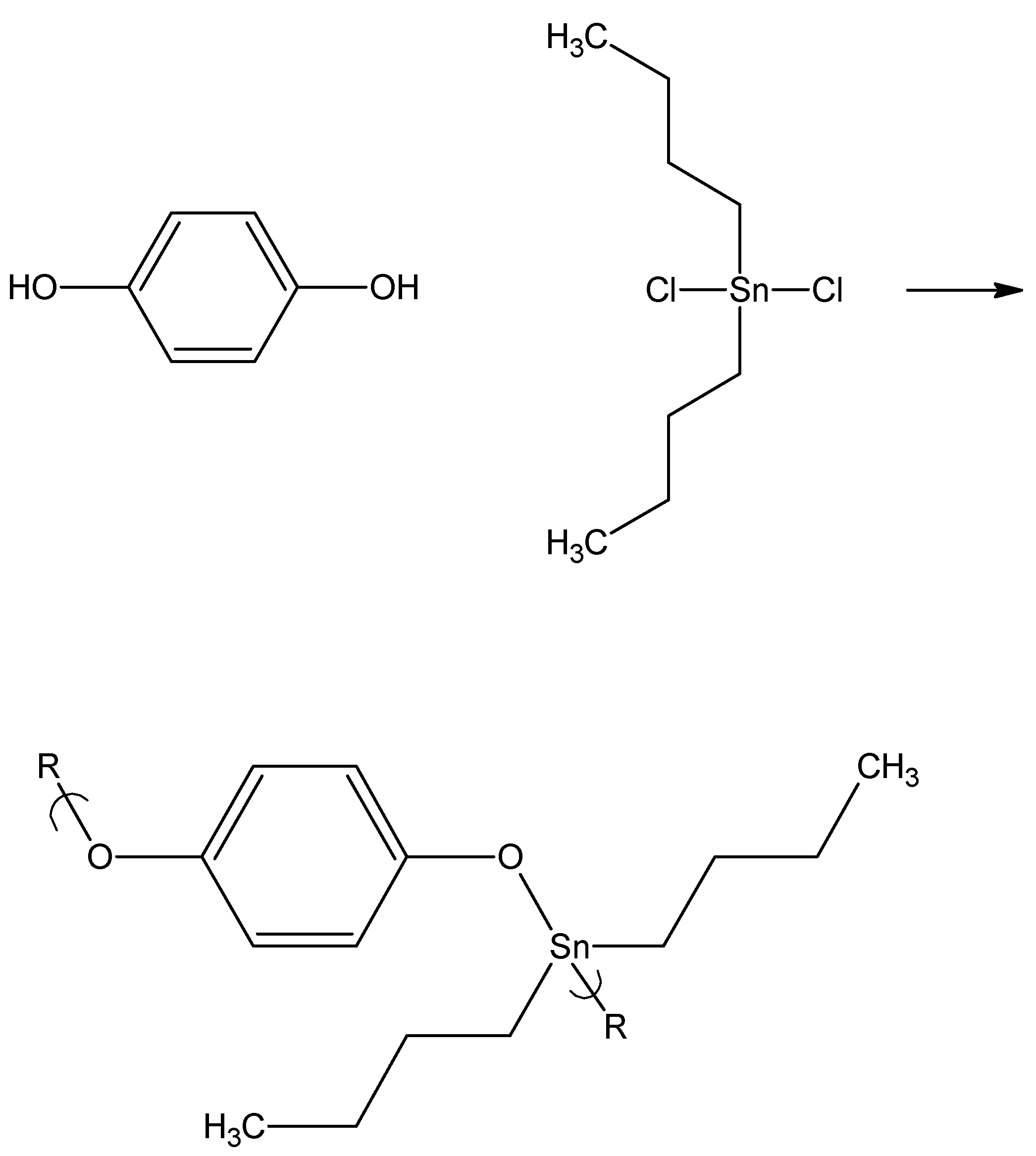
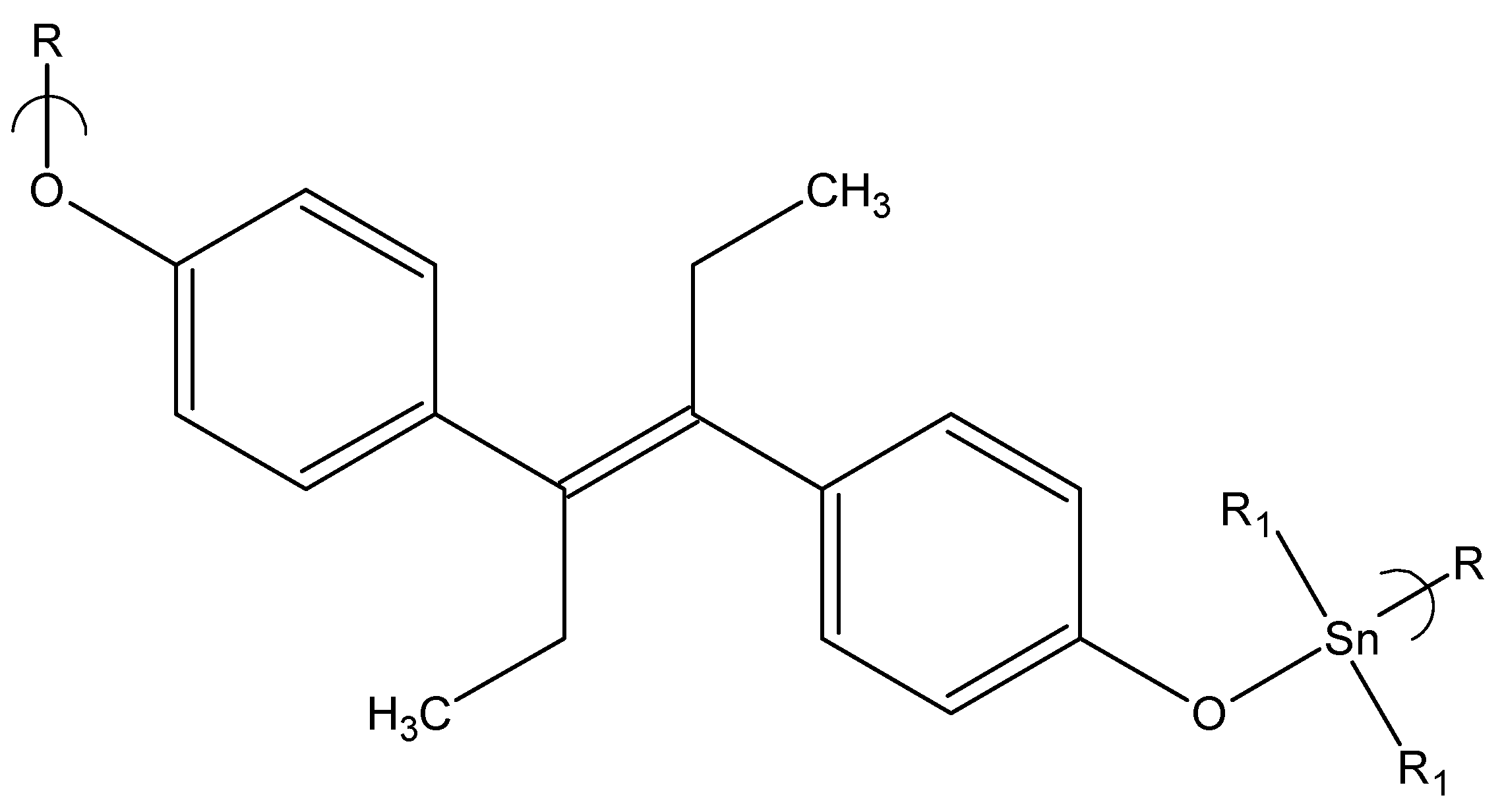
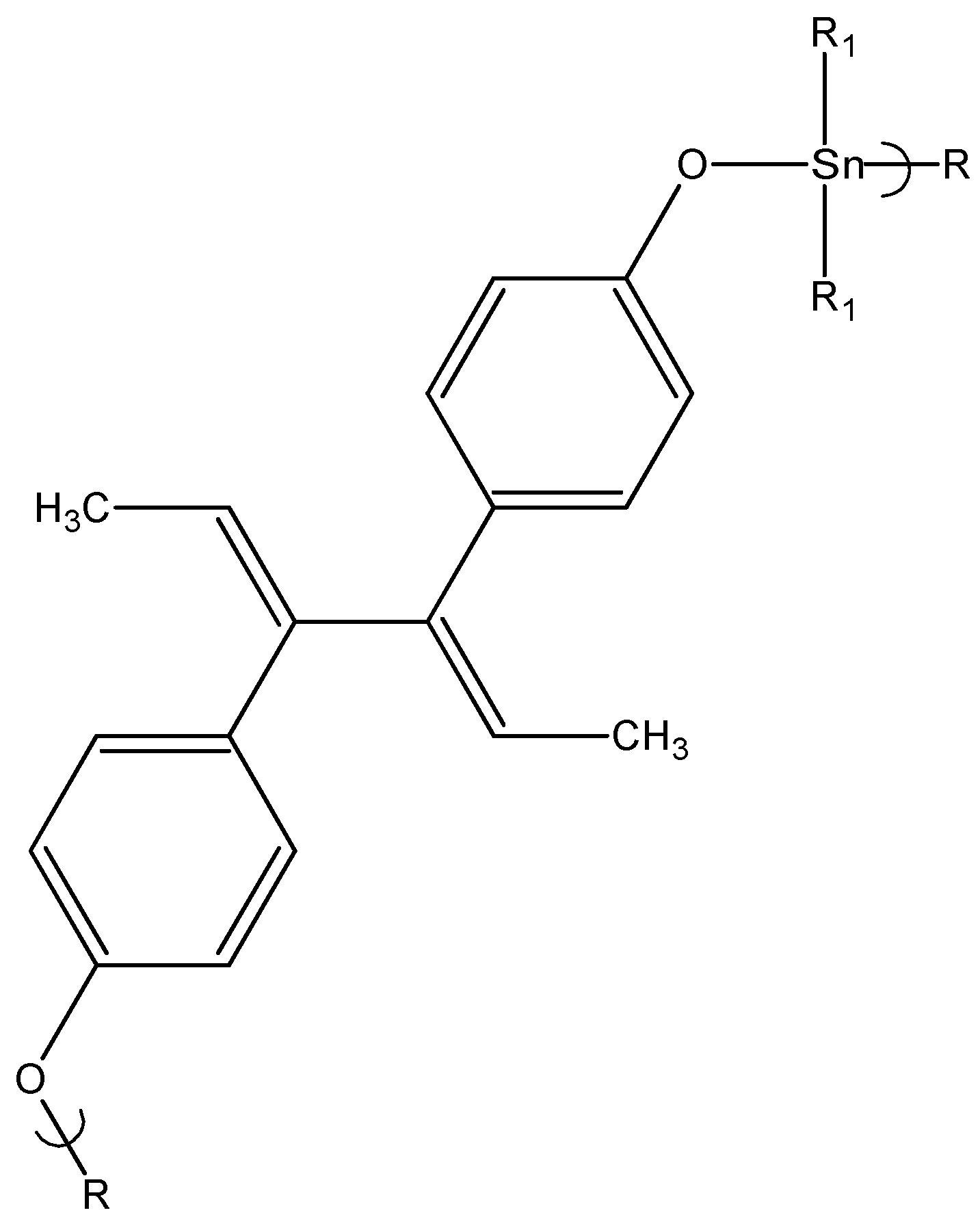
2.5.1. Summary of Cancer Results
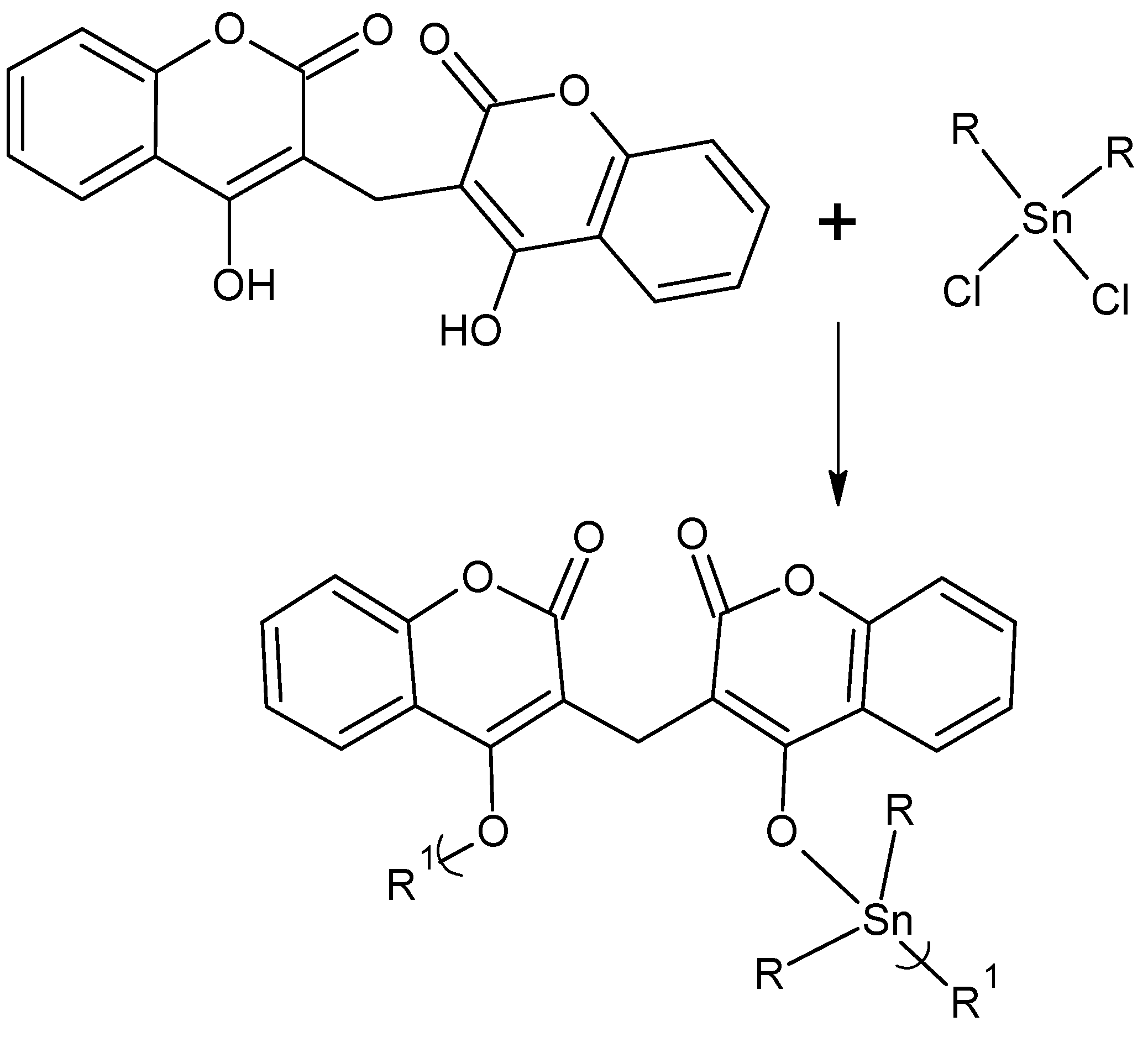
2.5.2. Bacterial
2.5.3. Viruses
3. Experimental
3.1. Synthesis of Organotins
- The classical system where the Lewis base, generally along with an added base, is dissolved in water and the second phase consists of the Lewis acid, here the organotin-containing reactant, dissolved in a suitable organic liquid.
- The non-aqueous two-phase systems employ two liquids that are largely immiscible in one another such as dissolving the Lewis base in acetonitrile, nitrobenzene, or 2,5-hexadione and the acid chloride, here the organotin reactant, in a non-polar organic liquid such as hexane, decane, or carbon tetrachloride.
- The non-organic solvent systems where the Lewis base is dissolved in water and a liquid Lewis acid such as tripropyltin chloride is used neat.
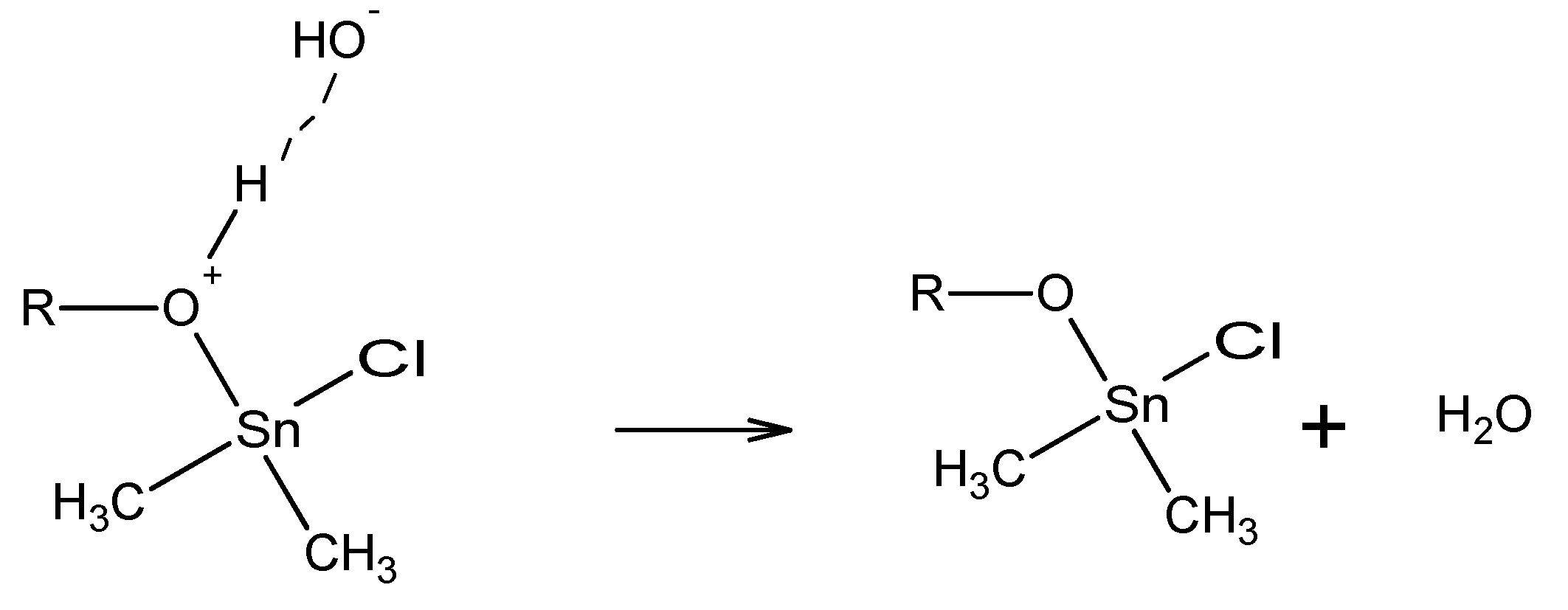
3.1.1. Preformed Polymers
3.1.2. Lignin
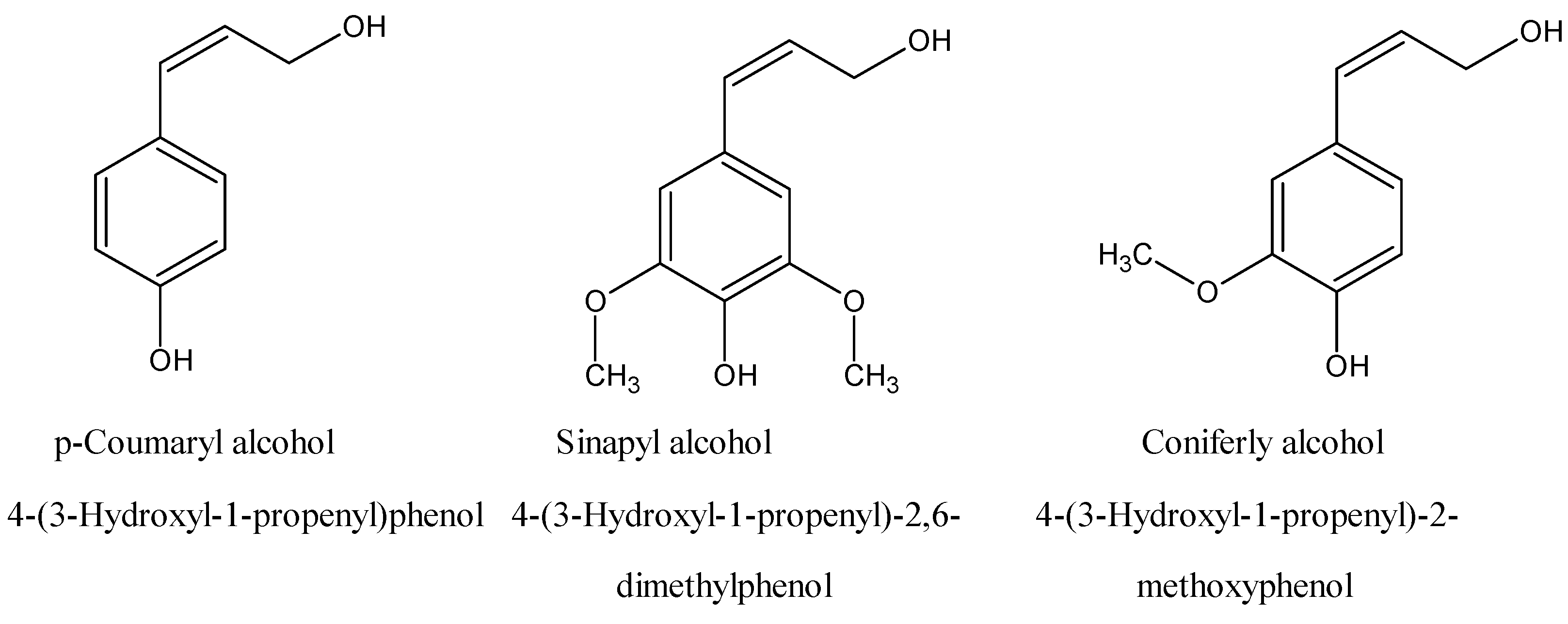
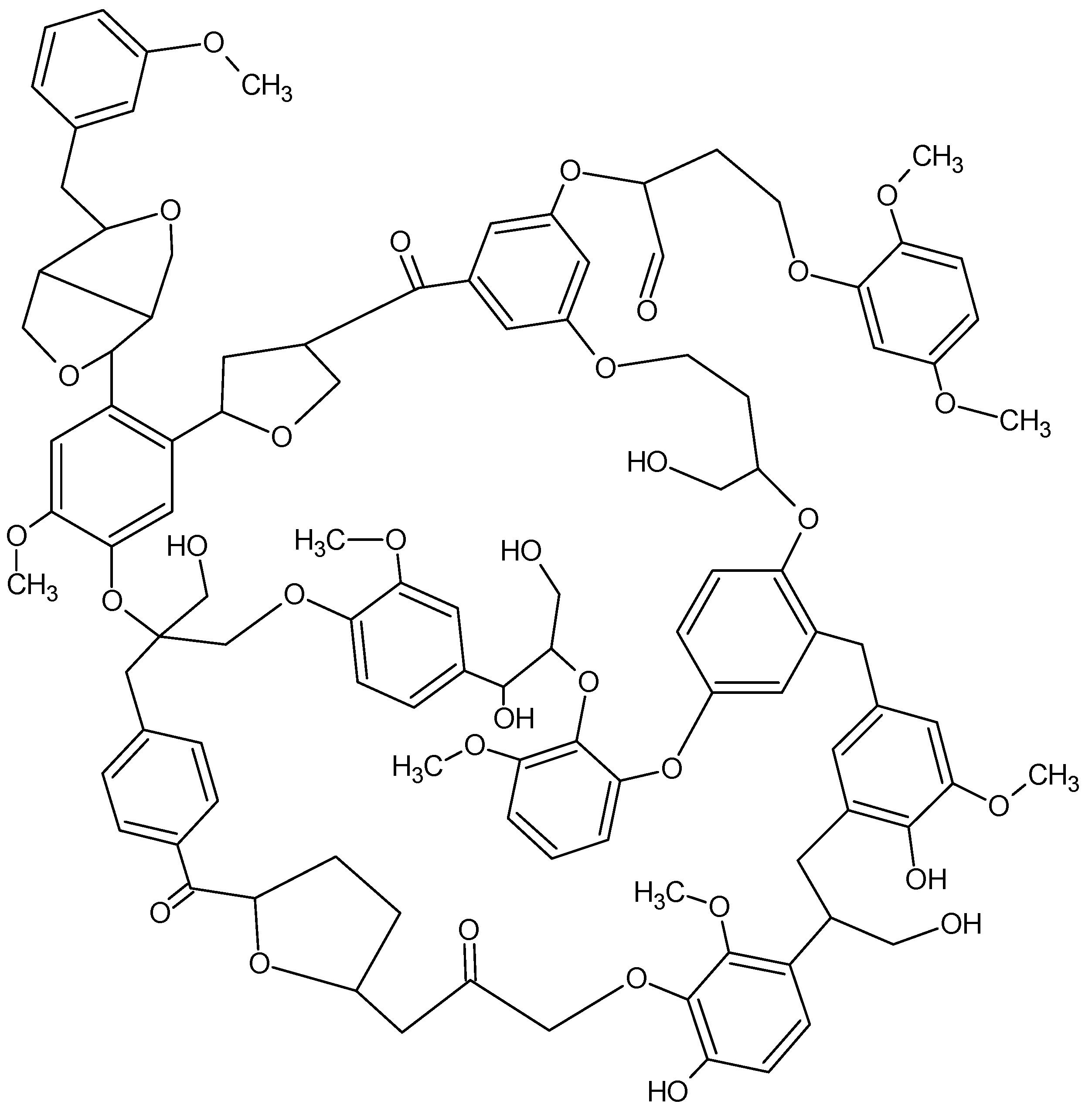
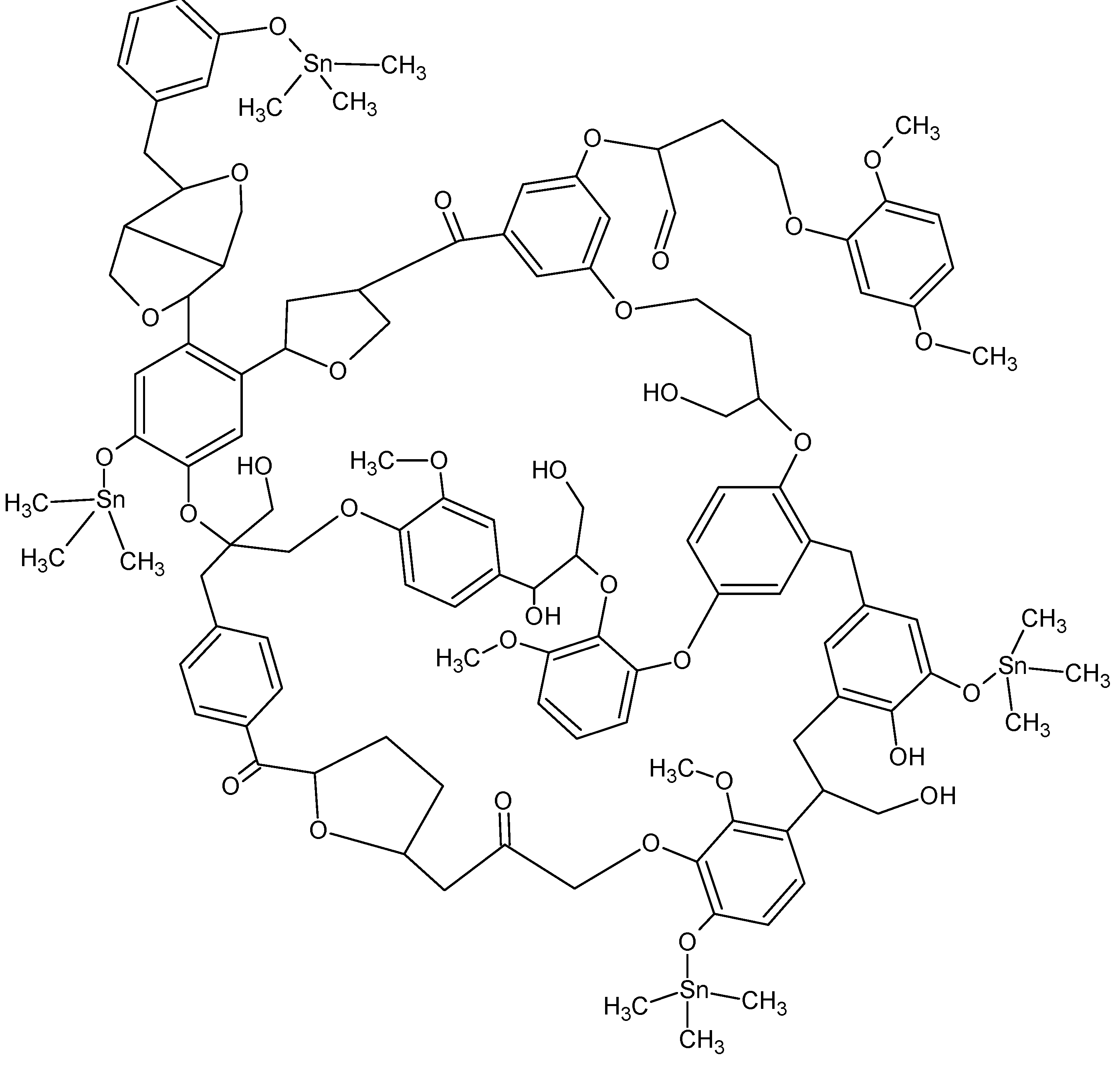
3.1.3. Poly(vinyl alcohol)

3.2. Synthesis of Polysaccharides
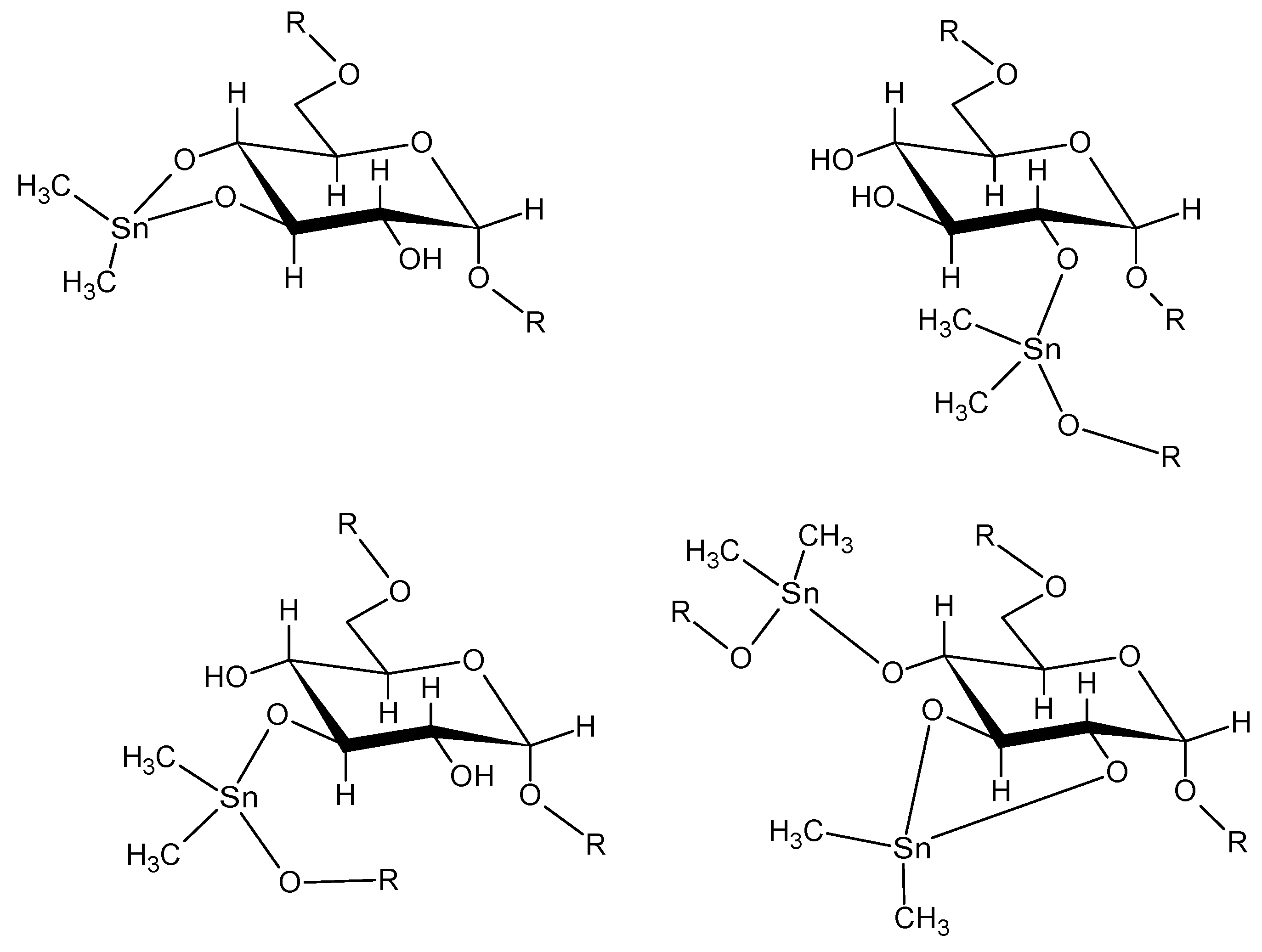
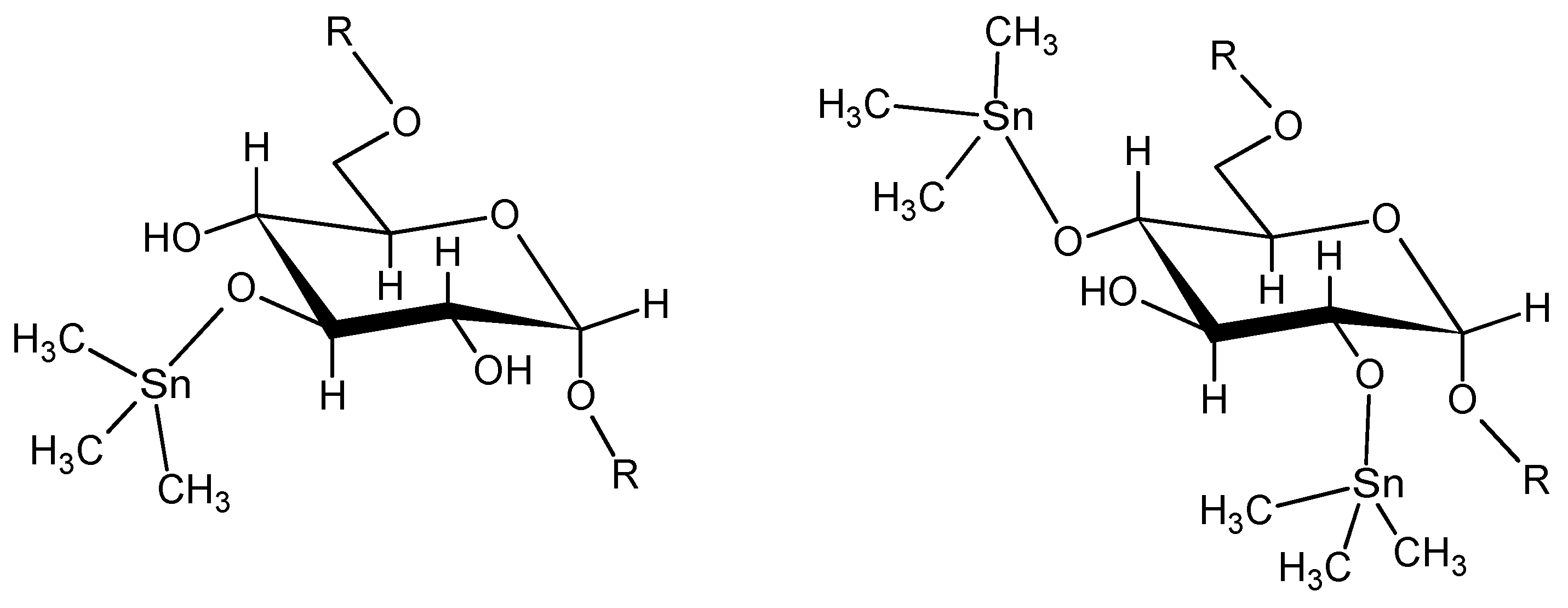
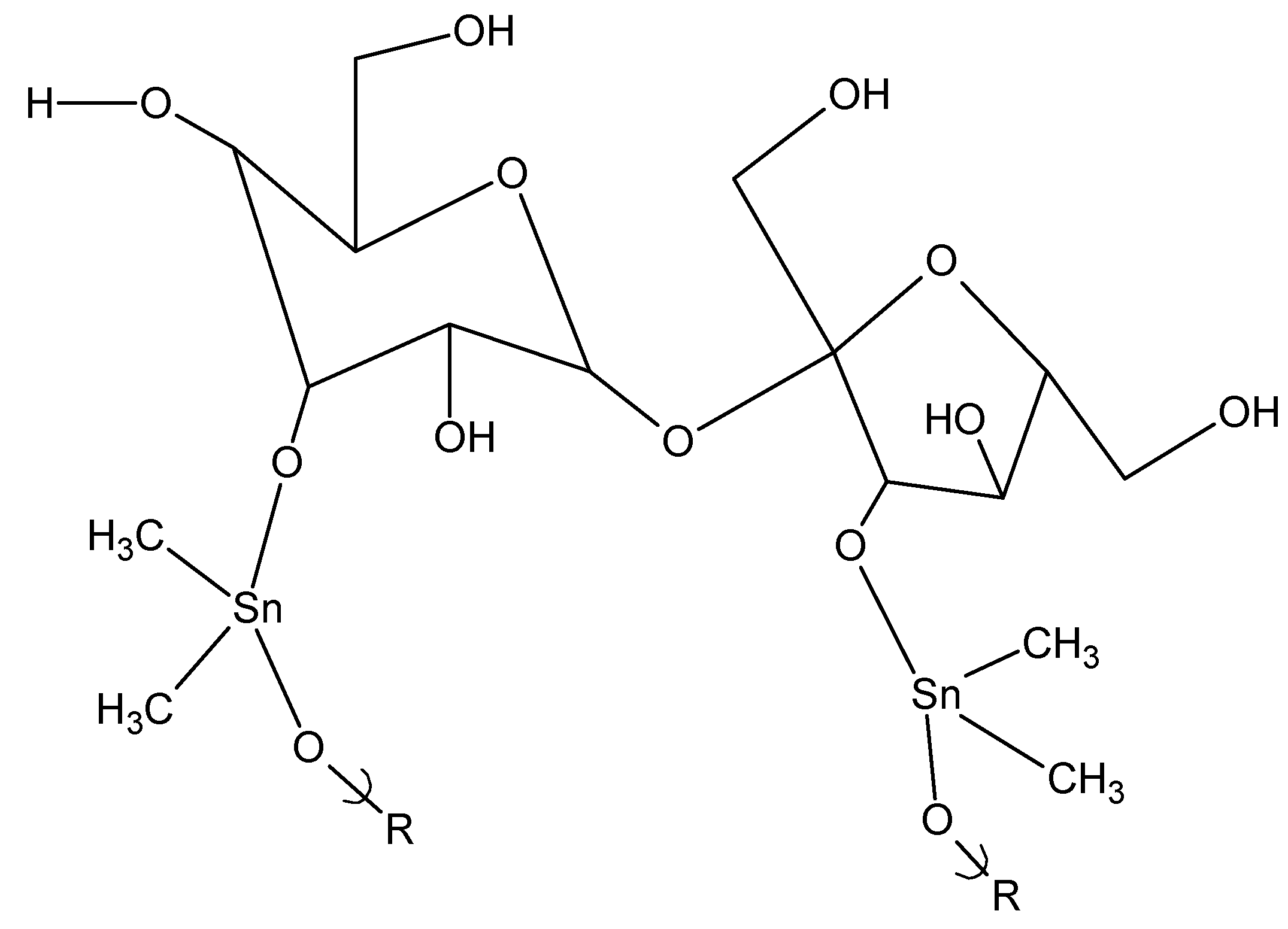
4. Conclusions
References and Notes
- Hoch, M. Organotin compounds in the environment—An overview. Appl. Geochem. 2001, 16, 719–743. [Google Scholar] [CrossRef]
- Carraher, C.E. Group IVA Polymers, Organotin Polymers; Wiley: Hoboken, NJ, USA, 2005; Vol. 4. [Google Scholar]
- Fent, K. Organotin in municipal wastewater and sewage sludge. In Organotin: Environmental Fate and Effects; Champ, M.A., Seligman, P., Eds.; Springer: New York, NY, USA, 1996; pp. 581–600. [Google Scholar]
- Wei, R.; Ya, L.; Jinguo, W.; Qifeng, X. Organotin Polymers, Polymer Materials Encyclopedia; Salamone, J., Ed.; CRC Press: Boca Raton, FL, USA, 1998. [Google Scholar]
- Van der Kerk, G.J.M. The organic chemistry of tin. Chemtech 1978, 8, 356–365. [Google Scholar]
- Snoeij, N.J.; Penninks, A.H.; Seinen, W. Biological activity of organotin compounds—An overview. Environ. Res. 1987, 44, 335–353. [Google Scholar] [CrossRef] [PubMed]
- Sasaki, Yu.F.; Sakaguchi, M.; Yamada, H.; Miyahara, T.; Kozuka, H. Antagonizing effect of triphenyltin chloride on cytosine-1-beta-D-arabinofuranoside potentiation of chromosome aberrations induced by mitomycin C. Mutat. Res. 1994, 323, 99–104. [Google Scholar] [CrossRef] [PubMed]
- Kishta, O.; Adeeko, A.; Li, D.; Luu, T.; Brawer, J.R.; Morales, C.; Hermo, L.; Robaire, B.; Hales, B.F.; Barthelemy, J.; Cyr, D.G.; Trasler, J.M. In utero exposure to tributyltin chloride differentially alters male and female fetal gonad morphology and gene expression profiles in the Sprague-Dawley rat. Reprod. Toxicol. 2007, 23, 1–11. [Google Scholar] [CrossRef] [PubMed]
- Dopp, E.; Hartmann, L.M.; von Recklinghausen, U.; Florea, A.M.; Rabieh, S.; Shokouhi, B.; Hirner, A.V.; Obe, G.; Rettenmeier, A.W. The cyto- and genotoxicity of organotin compounds is dependent on the cellular uptake capability. Toxicology 2007, 232, 226–234. [Google Scholar] [CrossRef] [PubMed]
- Cima, F.; Bragadin, M.; Ballarin, L. Toxic effects of new antifouling compounds on tunicate haemocytes I. Sea-nine 211 and chlorothalonil. Aquat. Toxicol. 2008, 86, 299–312. [Google Scholar] [CrossRef]
- Thomas, L.D.; Shah, H.; Green, S.A.; Bankhurst, A.D.; Whalen, M.M. Tributyltin exposure causes decreased granzyme B and perforin levels in human natural killer cells. Toxicology 2004, 200, 221–233. [Google Scholar] [CrossRef] [PubMed]
- Fent, K. Ecotoxicological problems associated with contaminated sites. Toxicol. Lett. 2003, 140/141, 353–365. [Google Scholar]
- Fent, K. Ecotoxicological effects at contaminated sites. Toxicology 2004, 205, 223–240. [Google Scholar] [CrossRef] [PubMed]
- Carraher, C.; Scherubel, G. Synthesis of poly[alkylene(arylene)oxystannanes] using a new modified system. Makromol. Chem. 1972, 152, 61–66. [Google Scholar] [CrossRef]
- Carraher, C.; Scherubel, G. Synthesis of polyoxystannyloxyalkylenes. J. Poly. Sci. 1971, 9(A-1), 983–989. [Google Scholar]
- Carraher, C.; Scherubel, G. Synthesis of poly(tin ethers) employing alkoxides. Makromol. Chem. 1972, 160, 259–264. [Google Scholar] [CrossRef]
- Carraher, C.E.; Lee, J.L. Synthesis of simple organotin polyethers using a new technique. Abstr. Pap. Am. Chem. S 2004, 227, U527–U527. [Google Scholar]
- Wei, R.; Liang, Y.; Wu, J.; Zhao, J.; Dong, Z. Synthesis and property of new organo-tin thermal stabilizers [in Chinese]. Yingyong Huaxue 1995, 12, 29–32. [Google Scholar]
- Wei, R.; Liang, Y.; Xue, Q. Synthesis and properties of organo-tin polyethers [in Chinese]. Gaofenzi Xuebao 1992, 4, 403–409. [Google Scholar]
- Han, Z.; Wang, Z.; Zhuang, H. Synthesis and structure characterization of organostannane polydyes [in Chinese]. Gongneng Gaofenzi Xuebao 1989, 2, 309–314. [Google Scholar]
- Siegmann-Louda, D.; Carraher, C.; Nagy, D.; Snedden, D.; Ross, J. Simple organotin polyethers as potential anti-cancer drugs. Polym. Mater. Sci. Eng. 2003, 89, 487–488. [Google Scholar]
- Barot, G.; Shahi, K.; Roner, M.; Carraher, C. Synthesis, structural characterization, and ability to inhibit cancer growth of a series of organotin poly(ethylene glycols). J. Inorg. Organomet. Polym. Mater. 2007, 17, 595–603. [Google Scholar] [CrossRef]
- van der Kerk, G.J.M. The biocidal properties of organotin compounds. J. App. Chem. 1954, 4, 314–310. [Google Scholar] [CrossRef]
- van der Kerk, G.J.M.; Luitjten, J.G.A. Investigations on organotin compounds. V. The preparation and antifundal properties of unsymmetrical tri-n-alkyltin acetates. J. App. Chem. 1956, 6, 56–60. [Google Scholar]
- Hadjikakou, S.K.; Ozturk, II; Xanthopoulou, M.N.; Zachariadis, P.C.; Zartilas, S.; Karkabounas, S.; Hadjiliadis, N. Synthesis, structural characterization and biological study of new organotin(IV), silver(I) and antimony(III) complexes with thioamides. J. Inorg. Biochem. 2008, 102, 1007–1015. [Google Scholar]
- Chasapis, C.T.; Hadjikakou, S.K.; Garoufis, A.; Hadjiliads, N.; Bakas, T.; Kubicki, M.; Ming, Y. Organotin(IV) derivatives of L-cysteine and their in vitro anti-tumor properties. Bioinorg. Chem. Appl. 2004, 43–54. [Google Scholar] [CrossRef]
- Holden, L.J.; Coleman, M.D. Assessment of the astrogliotic responses of three human astrocytoma cell lines to ethanol, trimethyltin chloride and acrylamide. Toxicology 2007, 241, 75–83. [Google Scholar] [CrossRef] [PubMed]
- Alama, A.; Viale, M.; Cilli, M.; Bruzzo, C.; Novelli, F.; Tasso, B.; Sparatore, F. In vitro cytotoxic activity of tri-n-butyltin(IV)lupinylsulfide hydrogen fumarate (IST-FS 35) and preliminary antitumor activity in vivo. Invest New Drugs 2009, 27, 124–130. [Google Scholar] [CrossRef] [PubMed]
- Koch, B.; Baul, T.S.; Chatterjee, A. Cell proliferation inhibition and antitumor activity of novel alkyl series of diorganotin(IV) compounds. J. Appl. Toxicol. 2008, 28, 430–438. [Google Scholar] [CrossRef] [PubMed]
- Nielsen, J.B.; Rasmussen, T.H. Antiproliferative effect of butyltin in MCF-7 cells. Environ. Res. 2004, 96, 305–310. [Google Scholar] [CrossRef] [PubMed]
- James, B.D.; Gioskos, S.; Chandra, S.; Magee, R.J.; Cashion, J.D. Some triphenyltin(IV) complexes containing potentially bidentate, biologically active anionic groups. J. Organometal. Chem. 1992, 436, 155–167. [Google Scholar] [CrossRef]
- Chandra, S.; Gioskos, S.; James, B.D.; Macauley, B.; Magee, R. Studies on the fungicidal properties of some triphenyltin(IV) compounds. J. Chem. Technol. Biotechnol. 1993, 56, 41–44. [Google Scholar] [CrossRef]
- James, B.D.; Kivlighon, L.; Skelton, B.; White, A.H. Triphenyltin(IV) compounds with biologically active anionic groups: crystal and molecular structures of the p-ethoxybenzoic acid, acetylsalicylic acid, phthalic acid and salicylaldehyde derivatives. App. Organometal. Chem. 1998, 12, 13–23. [Google Scholar] [CrossRef]
- Hadjikakou, S.; Hadjiliadis, N. Antiproliferative and anti-tumor activity of organotin compounds. Coord. Chem. Revs. 2009, 253, 235–249. [Google Scholar] [CrossRef]
- Ma, C.L.; Han, Y.W.; Zhang, R.F. Syntheses and crystal structures of di- and triorganotin(IV) derivatives with 2,4,5-trifluoro-3-methoxybenzoic acid. Polyhedron 2006, 25, 235–249. [Google Scholar] [CrossRef]
- Saxena, A.K.; Huber, F. Organotin compounds and cancer chemotherapy. Coord. Chem. Rev. 1989, 95, 109–123. [Google Scholar] [CrossRef]
- Xanthopoulou, M.N.; Hadjiliadis, N. Synthesis and characterization of a new chloro-di-phenyltin(IV) complex with 2-mercapto-nicotinic acid: Study of its influence upon the catalytic oxidation of linoleic acid to hydroperoxylinoleic acid by the enzyme lipoxygenase. J. Organometal. Chem. 2006, 691, 1780–1789. [Google Scholar] [CrossRef]
- Xanthopoulou, M.N.; Hadjikakou, S.K.; Hadjiliadis, N.; Milaeva, E.R.; Gracheva, J.A.; Tyurin, V.Y.; Kourkoumelis, N.; Christoforidis, K.C.; Metsios, A.K.; Karkabounas, S.; Charalabopoulos, K. Biological studies of new organotin(IV) complexes of thioamide ligands. Eur. J. Med. Chem. 2008, 43, 327–335. [Google Scholar] [CrossRef] [PubMed]
- Xanthopoulou, M.N.; Hadjikakou, S.K.; Hadjiliadis, N. Biological studies of organotin(IV) complexes with 2-mercaptopyrimidine. Russian Chem. Bull. 2007, 56, 767–773. [Google Scholar] [CrossRef]
- Xanthopoulou, M.N.; Hadjikakou, S.K.; Hadjiliadis, N. Communication: synthesis of a novel triphenyltin(IV) derivative of 2- mercaptonicotinic acid with potent cytotoxicity in vitro. Bioinorg. Chem. Appl. 2004, 1, 227–231. [Google Scholar] [CrossRef]
- Arakawa, Y. Recent Studies on the Mode of Biological Action of the di- and tri-Alkyltin Compounds; Blackie Academic & Professional, Chapman & Hall: Glasgow, UK, 1998. [Google Scholar]
- Arakawa, Y. Biological Properties of Alkyltin Compounds; Marcel Dekker: New York, NY, USA, 1993; Vol. 29. [Google Scholar]
- Arakawa, Y. Cellular and Biochemical Aspects of Antitumor Activity of Organotin Compounds; Narosa Publishing House: New Dehli, India, 1996. [Google Scholar]
- Arakawa, Y. Antitumor Activity of Organotin Compounds and Inhibition of Membrane Signal Transduction; Oxford University Press: Oxford, UK, 1992. [Google Scholar]
- Arakawa, Y. Suppression of Cell Proliferation by Certain Organotin Compounds; CRC Press: Boca Raton, FL, USA, 1988. [Google Scholar]
- Arakawa, Y. Tin and immunity-Review. Biomed. Res. Trace Elements 1995, 6, 34–96. [Google Scholar]
- Arakawa, Y. Invasion of biofunctions by organotins -immune system, brain nervous system and endocrine system. Biomed. Res. Trace Elements 2000, 11, 259–286. [Google Scholar]
- Arakawa, Y. Morbid aging of thymus immunity by metals. Biomed. Res. Trace Elements 2003, 14, 249–258. [Google Scholar]
- Li, P.; Nijhawan, D.; Budihardjo, I.; Srinivasula, S.M.; Ahmad, M.; Alnemri, E.S.; Wang, X.D. Cytochrome c and dATP-dependent formation of Apaf-1/caspase-9 complex initiates an apoptotic protease cascade. Cell 1997, 91, 479–489. [Google Scholar] [CrossRef] [PubMed]
- Li, H.L.; Zhu, H.; Xu, C.J.; Yuan, J.Y. Cleavage of BID by caspase 8 mediates the mitochondrial damage in the Fas pathway of apoptosis. Cell 1998, 94, 491–501. [Google Scholar] [CrossRef] [PubMed]
- Luo, X.; Budihardjo, I.; Zou, H.; Slaughter, C.; Wang, X.D. Bid, a Bcl2 interacting protein, mediates cytochrome c release from mitochondria in response to activation of cell surface death receptors. Cell 1998, 94, 481–490. [Google Scholar] [CrossRef] [PubMed]
- Enari, M.; Sakahira, H.; Yokoyama, H.; Okawa, K.; Iwamatsu, A.; Nagata, S. A caspase-activated DNase that degrades DNA during apoptosis, and its inhibitor. Nature 1998, 393, 43–50. [Google Scholar] [CrossRef]
- Sakahira, H.; Enari, M.; Nagata, S. Cleavage of CAD inhibitor in CAD activation and DNA degradation during apoptosis. Nature 1998, 391, 96–99. [Google Scholar] [CrossRef] [PubMed]
- Murayama, N.; Suzuki, H.; Arakawa, Y. Organotin induced thymus atrophy and apoptosis. Trace Nutr. Res. 2001, 18, 53–56. [Google Scholar]
- Arakawa, Y. Chemistry of Tin; Elsevier: New York, NY, USA, 1998. [Google Scholar]
- Jan, C.; Jiann, B.; Lu, Y.; Chang, H.; Su, W.; Chen, W.; Yu, C.; Huang, J. Effect of the organotin compound triethyltin on Ca2+ handling in human prostate cancer cells. Life Sci. 2000, 70, 1337–1345. [Google Scholar] [CrossRef]
- Parfett, C.L.J.; Marquardt, T.; Pilon, R. Promotion of morphological transformation by di-n-butyltin dichloride in C3H/10T1/2 cells: Prediction by prior expression of tumour promoter-responsive genes. Food Chem. Toxicol. 2000, 38, 339–349. [Google Scholar] [CrossRef] [PubMed]
- Powers, M.F.; Beavis, A.D. Triorganotins inhibit the mitochondrial inner membrane anion channel. J. Biol. Chem. 1991, 266, 17250–17256. [Google Scholar] [PubMed]
- Stridh, H.; Cotgreave, I.; Muller, M.; Orrenius, S.; Gigliotti, D. Organotin-induced caspase activation and apoptosis in human peripheral blood lymphocytes. Chem. Res. Toxicol. 2001, 14, 791–798. [Google Scholar] [CrossRef] [PubMed]
- Whalen, M.M.; Loganathan, B.G. Butyltin exposure causes a rapid decrease in cyclic AMP levels in human lymphocytes. Toxicol. Appl. Pharmacol. 2001, 171, 141–148. [Google Scholar] [CrossRef] [PubMed]
- Yamabe, Y.; Hoshino, A.; Imura, N.; Suzuki, T.; Himeno, S. Enhancement of androgen-dependent transcription and cell proliferation by tributyltin and triphenyltin in human prostate cancer cells. Toxicol. Appl. Pharmacol. 2000, 169, 177–184. [Google Scholar] [CrossRef] [PubMed]
- Yamanoshita, O.; Kurasaki, M.; Saito, T.; Takahasi, K.; Sasaki, H.; Hosokawa, T.; Okabe, M.; Mochida, J.; Iwakuma, T. Diverse effect of tributyltin on apoptosis in PC12 cells. Biochem. Biophys. Res. Commun. 2000, 272, 557–562. [Google Scholar] [CrossRef] [PubMed]
- Barbieri, F.; Sparatore, F.; Cagnoli, M.; Bruzzo, C.; Novelli, F.; Alama, A. Antiproliferative activity and interactions with cell-cycle related proteins of the organotin compound triethyltin(IV)lupinylsulfide hydrochloride. Chem. Biol. Interact. 2001, 134, 27–39. [Google Scholar] [CrossRef] [PubMed]
- Ray, D.; Sarma, K.D.; Antony, A. Differential effects of tri-n-butylstannyl benzoates on induction of apoptosis in K562 and MCF-7 cells. IUBMB Life 2000, 49, 519–525. [Google Scholar] [CrossRef] [PubMed]
- Li, Q.; Yang, P.; Wang, H.; Guo, M. Diorganotin(IV) antitumor agent. (C2H5)2SnCl2 (phen)/nucleotides aqueous and solid-state coordination chemistry and its DNA binding studies. J. Inorg. Biochem. 1996, 64, 181–195. [Google Scholar]
- Appel, K.E. Organotin compounds: Toxicokinetic aspects. Drug Metab. Rev. 2004, 36, 763–786. [Google Scholar] [CrossRef] [PubMed]
- Gielen, M.; Willem, R.; Bouhdid, A.; De Vos, D.; Kuiper, C.M.; Veerman, G.; Peters, G.J. In vitro antiproliferative effects, toxicity profiles in vivo in mice and antitumour activity in tumour-bearing mice of five organotin compounds. In Vivo 1995, 9, 59–63. [Google Scholar] [PubMed]
- Samuel, P.M.; de Vos, D.; Raveendra, D.; Sarma, J.A.; Roy, S. 3-D QSAR studies on new dibenzyltin(IV) anticancer agents by comparative molecular field analysis (CoMFA). Bioorg. Med. Chem. Lett. 2002, 12, 61–64. [Google Scholar] [CrossRef] [PubMed]
- Nebbia, C.; Dacasto, M.; Ceppa, L.; Gennaro Soffietti, M.; Spinelli, P.; Bergo, V.; Di Simplicio, P. The comparative effects of subchronic administration of triphenyltin acetate (TPTA) on the hepatic and renal drug-metabolizing enzymes in rabbits and lambs. Vet. Res. Commun. 1997, 21, 117–125. [Google Scholar] [CrossRef] [PubMed]
- Siegmann-Louda, D.; Carraher, C. Polymeric Platinum-Containing Drugs in the Treatment of Cancer, in Macromolecules Containing Metal and Metal-Like Elements. Vol. 3. Biomedical Applications; Wiley: Hobokin, NJ, USA, 2004; Vol. 3, pp. 119–192. [Google Scholar]
- Goddard, P.; Williamson, I.; Brown, J.; Hutchinson, L.E.; Nicholls, J.; Petrak, K. Soluble polymeric carriers for drug delivery 4. Tissue autoradiography, and whole-body tissue distribution in mice, of N-(2-hydroxypropyl)methacrylamide copolymers following intravenous administration. J. Bioact. Compat. Polym. 1991, 6, 4–24. [Google Scholar]
- Phillips, P.C. Antineoplastic drug-resistance in brain-tumors. Neurol. Clin. 1991, 9, 383–404. [Google Scholar] [PubMed]
- Abdellaoui, K.; Boustta, M.; Morjani, H.; Manfait, M.; Vert, M. Uptake and intracellular distribution of 4-aminofluorescein-labelled poly(L-lysine citramide imide) in K562 cells. J. Drug Target. 1998, 5, 193–206. [Google Scholar] [CrossRef] [PubMed]
- Vasey, P.A.; Kaye, S.B.; Morrison, R.; Twelves, C.; Wilson, P.; Duncan, R.; Thomson, A.H.; Murray, L.S.; Hilditch, T.E.; Murray, T.; Burtles, S.; Fraier, D.; Frigerio, E.; Cassidy, J.; Comm, C.R.C.P.I.I. Phase I clinical and pharmacokinetic study of PK1 [N-(2-hydroxypropyl)meth-acrylamide copolymer doxorubicin]: First member of a new class of chemotherapeutic agents— Drug-polymer conjugates. Clin. Cancer Res. 1999, 5, 83–94. [Google Scholar] [PubMed]
- Chourasia, M.K.; Jain, S.K. Polysaccharides for colon targeted drug delivery. Drug Deliv. 2004, 11, 129–148. [Google Scholar] [CrossRef] [PubMed]
- Fournier, E.; Passirani, C.; Colin, N.; Breton, P.; Sagodira, S.; Benoit, J.P. Development of novel 5-FU-loaded poly(methylidene malonate 2.1.2)-based microspheres for the treatment of brain cancers. Eur. J. Pharm. Biopharm. 2004, 57, 189–197. [Google Scholar]
- Ulbrich, K.; Subr, V. Polymeric anticancer drugs with pH-controlled activation. Adv. Drug Deliv. Rev. 2004, 56, 1023–1050. [Google Scholar] [CrossRef] [PubMed]
- Doucett, R.; Siegmann-Louda, D.; Carraher, C. Inhibition of human ovarian adenocarcinoma cells by organotin polyamines derived from 2-chloro-1,4-benzenediamine in dilute aqueous HMPA and aqueous DMSO solutions. Polym. Mater. Sci. Eng. 2004, 91, 569–570. [Google Scholar]
- Abs-El-Aziz, A.; Carraher, C.; Pittman, C.; Sheats, J.; Zeldin, M. A Half Century of Metal- and Metalloid-Containing Polymers; Taylor and Francis: New York, NY, 2008; Vol. 7. [Google Scholar]
- Carraher, C. Polymer Chemistry; Taylor & Francis: New York, NY, 2008. [Google Scholar]
- Carraher, C.; Sabir, T.; Carraher, C.L. Fundamentals of Fragmentation Matrix Assisted Laser Desorption/Ionization Mass Spectrometry; Springer: New York, NY, 2008. [Google Scholar]
- Carraher, C.; Sabir, T.; Carraher, C.L. Fragmentation matrix assisted laser desorption/ionization mass spectrometry-basics. J. Polym. Mater. 2006, 23, 143–151. [Google Scholar]
- Carraher, C.E.; Barot, G.; Battin, A. Reactions between the matrix and ion fragments created from the MALDI MS of organotin-containing polymers. J. Polym. Mater. 2009, 26, 17–31. [Google Scholar]
- Claeyssens, M.; van Tilbeurgh, H.; Kamerling, J.P.; Berg, J.; Vrsanska, M.; Biely, P. Studies of the cellulolytic system of the filamentous fungus Trichoderma reesei QM 9414. Substrate specificity and transfer activity of endoglucanase I. Biochem. J. 1990, 270, 251–256. [Google Scholar]
- Lamot, E.; Voets, J.P. Microbial biodegradation of cellophase. Z. Allg. Mikrobiol. 1978, 18, 183–188. [Google Scholar] [CrossRef] [PubMed]
- Naoshima, Y.; Carraher, C.E.; Gehrke, T.J.; Kurokawa, M.; Blair, D. Chemical modification of dextran through reaction with biscyclopentadienyltitanium dichloride and dibutyltin dichloride as a function of the reaction system. J. Macromol. Sci. Chem. 1986, A23, 861–873. [Google Scholar] [CrossRef]
- Carraher, C.; Butler, C. Materials and methods for controlling methicillin-resistant Staphlococcus Aureus microbes. US Pat. 5,840,760, 1998. [Google Scholar]
- Carraher, C.; Saurino, V.; Butler, C.; Sterling, D. Modified natural hydroxyl-containing products employed in the treatment of specific disease. Abstr. Pap. Am. Chem. Soc 1995, 209, 115-PMSE. [Google Scholar]
- Barot, G.; Roner, M.; Carraher, C. Molecular weight control of organotin polyethers synthesized by interfacial polymerization. Polym. Mater. Sci. Eng. 2008, 98, 387–389. [Google Scholar]
- Barot, G.; Carraher, C. Stability of water-soluble organotin ethylene glycol polyethers as a function of time. Polym. Mater. Sci. Eng. 2008, 99, 393–395. [Google Scholar]
- Barot, G.; Vetter, S.; Nayak, G.; Roner, M.; Carraher, C. Enzymatic effects on the organotin polyether derived from dibutyltin dichloride and hydroxyl-capped poly(ethylene glycol) and evaluation of Trypsin activity employing light scattering photometry and gel electrophoresis. Polym. Mater. Sci. Eng. 2009, 101, 1383–1384. [Google Scholar]
- Shahi, K.; Roner, M.; Barot, G.; Carraher, C. Ability to inhibit various cancer cell lines by dibutyltin polyethers derived from 1,1- and 1,2-diols. Polym. Mater. Sci. Eng. 2008, 99, 349–351. [Google Scholar]
- Carraher, C.; Barot, G. Synthesis of organotin polyethers from diols containing varying methylene separators. Polym. Mater. Sci. Eng. 2006, 95, 535–537. [Google Scholar]
- Shahi, K.; Roner, M.; Barot, G.; Carraher, C. Ability of a series of organotin polyethers containing methylene spacers to inhibit prostrate, breast, colon, and lung cancer cell lines. Polym. Mater. Sci. Eng. 2008, 98, 375–377. [Google Scholar]
- Barot, G.; Shahi, K.R.; Roner, M.R.; Carraher, C.E. Synthesis, anomalous fiber formation, and preliminary anticancer study of the organotin polyether derived from 2-butyne-1,4-diol. J. Polym. Mater. 2006, 23, 423–436. [Google Scholar]
- Barot, G.; Roner, M.; Shahi, K.; Carraher, C. Synthesis and structural and preliminary anticancer characterization of the organotin polyether from dibutyltin dichloride and 2,4-dimethyl-3-hexyne-2,5-diol. Polym. Mater. Sci. Eng. 2008, 99, 383–385. [Google Scholar]
- Barot, G.; Carraher, C. Fiber formation and MALDI TOF MS results for the polyether from 2,5-dimethyl-3-hexyne-2,5-diol and dibutyltin dichloride. Polym. Mater. Sci. Eng. 2008, 99, 354–356. [Google Scholar]
- Barot, G.; Carraher, C. Polymeric Organotin Fibers; Springer: New York, NY, 2008. [Google Scholar]
- Carraher, C. Fiber forming and thermal properties of polyesters of group IV B metals. Chem. Technol. 1972, 741–744. [Google Scholar]
- Barot, G.; Roner, M.R.; Naoshima, Y.; Nagao, K.; Shahi, K.; Carraher, C.E. Synthesis, structural characterization, and preliminary biological characterization of organotin polyethers derived from hydroquinone and substituted hydroquinones. J. Inorg. Organomet. P 2009, 19, 12–27. [Google Scholar] [CrossRef]
- Carraher, C.; Roner, M.R.; Shahi, K.; Ashida, Y.; Barot, G. Synthesis and initial cell line results of organotin polyethers containing diethylstilbestrol. J. Inorg. Organomet. Polym. Mater. 2008, 18, 180–188. [Google Scholar] [CrossRef]
- Swain, S.M.; Lippman, M.E. Cancer Chemotherapy. Lipincott: Philadelphia, PA, USA, 1990. [Google Scholar]
- Vogelzang, N.J. Cancer Chemotherapy; Williams & Wilkins: New York, NY, USA, 1992. [Google Scholar]
- Carraher, C.; Ashida, Y.; Barot, G. Organotin polymers from the hormone dienestrol. Polym. Mater. Sci. Eng. 2009, 100, 22–25. [Google Scholar]
- Shahi, K.; Roner, M.; Ashida, Y.; Barot, G.; Carraher, C. Ability of organotin polyethers derived from dienestrol to inhibit ovarian, colon, lung, and breast cancer cells. Polym. Mater. Sci. Eng. 2009, 100, 22–25. [Google Scholar]
- Vogelzang, N. Chemotherapy Source Book; Williams & Wilkins: New York, NY, USA, 1992; Vol. 1008. [Google Scholar]
- Roner, M.R.; Shahi, K.R.; Barot, G.; Battin, A.; Carraher, C.E. Preliminary results for the inhibition of pancreatic cancer cells by organotin polymers. J. Inorg. Organomet. P 2009, 19, 410–414. [Google Scholar] [CrossRef]
- Roner, M.; Johnson, J.; Carraher, C. Ability of organotin polyethers derived from the anticoagulant dicumarol to inhibit ovarian, colon, lung, prostrate, pancreatic and breast cancer cells. Polym. Mater. Sci. Eng. 2009, in press. [Google Scholar]
- Carraher, C.; Naoshima, Y.; Nagao, K.; Mori, Y.; Zhao, A.; Barot, G.; Battin, A. Bacterial inhibition by Organotin-Containing Polymers; Springer: New York, NY, USA, 2008. [Google Scholar]
- Naoshima, Y.; Nagao, K.; Ashida, Y.; Carraher, C. Antiacterial and antiyeast activity of aliphatic organotin polyethers. Polym. Mater. Sci. Eng. 2007, 96, 396–398. [Google Scholar]
- Naoshima, Y.; Nagao, K.; Ashida, Y.; Carraher, C. Inhibition of bacteria, fungi, and yeast by polymeric organotin and group IVB metallocene polyether compounds containing the synthetic hormone diethylstilbestrol. Polym. Mater. Sci. Eng. 2007, 97, 652. [Google Scholar]
- Naoshima, Y.; Nagao, K.; Barot, G.; Carraher, C. Inhibition of bacteria and yeast by organotin polyethers derived from hydroquinone and hydroquinone derivatives. Polym. Mater. Sci. Eng. 2009, 100, 19–21. [Google Scholar]
- Shahi, K.; Roner, M.; Barot, G.; Carraher, C. Ability of dibutyltin poly(ethylene oxides) to inhibit the viruses associated with small pox and herpes. Polym. Mater. Sci. Eng. 2008, 99, 51–53. [Google Scholar]
- Shahi, K.; Roner, M.; Barot, G.; Carraher, C. Inhibition of the HSV-1 and Vaccinia viruses by organotin polyethers containing methylene spacers. Polym. Mater. Sci. Eng. 2009, 100, 51–53. [Google Scholar]
- Shahi, K.; Roner, M.; Barot, G.; Carraher, C. Ability of a series of organotin polyethers derived from substituted hydroquinone to inhibit the vaccinia and herpes simplex viruses. Polym. Mater. Sci. Eng. 2009, 100, 48–50. [Google Scholar]
- Morgan, P.W. Linear condensation polymers by low-temperature processes. Abstr. Pap. Am. Chem. Soc. 1976, 44. [Google Scholar]
- Millich, F.; Carraher, C. Interfacial Synthesis; Dekker: New York, NY, USA, 1977. [Google Scholar]
- Millich, F.; Carraher, C. Interfacial Synthesis. Vol. II; Dekker: New York, NY, USA, 1977. [Google Scholar]
- Carraher, C.; Preston, J. Interfacial Synthesis Vol. III; Dekker: New York, NY, USA, 1982. [Google Scholar]
- Carraher, C.E. Introduction to Polymer Chemistry; CRC/Taylor & Francis: Boca Raton, FL, USA, 2007; pp. 160–161. [Google Scholar]
- Carraher, C. Interfacial production of polyalkyloxysilanes and a study of some reaction variables. J. Polym. Sci. 1969, A-1, 2351–2358. [Google Scholar]
- Morgan, P.W.; Kwolek, S. The nylon rope trick. J. Chem. Edu. 1959, 36, 182–184. [Google Scholar] [CrossRef]
- Gertner, D.; Migdal, S.; Zilkha, A. Biocidal organotin derivatives of polymers. GB Pat. 1107929, 1968. [Google Scholar]
- Frankel, M.; Gertner, D.; Wagner, D.; Zilkha, A. Organotin polymers and copolymers. J. Organ. Chem. 1967, 9, 83–88. [Google Scholar] [CrossRef]
- Migdal, S.; Gertner, D.; Zilkha, A. Stannoxane oligomers and polymers. Eur. Polym. J. 1968, 4, 465–472. [Google Scholar] [CrossRef]
- Migdal, S.; Gertner, D.; Zilkha, A. Oligomeric stannoxanes. Can. J. Chem. 1968, 46, 2409–2413. [Google Scholar] [CrossRef]
- Carraher, C.; Sterling, D.; Ridgeway, T.; Louda, W. Structural Characterization of Organostannane-Kraft Lignin; Plenum: New York, NY, USA, 1991. [Google Scholar]
- Carraher, C.; Sterling, D.; Butler, C.; Ridgway, T. Use of Lignin-Based Materials in the Selective Inhibition of Microorganisms; Plenum: New York, NY, USA, 1994. [Google Scholar]
- Carraher, C.; Sterling, D.; Ridgway, T.; Reiff, W.; Pandya, B. Simultaneous Interpenetrating Network Products from Lignin, Organostannanes and Hydroxyl-Capped Poly(ethylene Oxide) with Polydimethylsiloxane. Polym. Mater. Sci. Eng. 1991, 65, 11–12. [Google Scholar]
- Carraher, C.; Piersma, J. Modification of poly(vinyl alcohol) through reaction with tin reactants. Polym. Mater. Sci. Eng. 1973, 28, 153–160. [Google Scholar]
- Carraher, C.; Butler, C.; Reckleben, L. Treatment of Yeast Infections Employing Organotin-Containing Modified Poly(vinyl alcohol); Plenum Press: New York, NY, USA, 1991. [Google Scholar]
- Carraher, C.; Reckleben, L.; Butler, C. Synthesis of organostannane-modified poly(vinyl alcohol) for the control of Candida albicans. Polym. Mater. Sci. Eng. 1990, 63, 704–708. [Google Scholar]
- Carraher, C.; Butler, C. Novel compounds for the control of microorganisms. US Pat. 5,043,463, 1991. [Google Scholar]
- Carraher, C.; Mykytiuk, P.; Blakall, H.; Linville, R.; Tiernan, T.; Coldiron, S. Structural Identification of the Condensation Product of Sucrose with Organostannane Dihalides; Plenum Press: New York, NY, USA, 1983. [Google Scholar]
- Carraher, C.; Butler, C. Biological Activities of Hydroxyl-Containing Natural Products Emphasizing Tin-Containing Products; Technomic: Lancaster, UK, 1993. [Google Scholar]
- Naoshima, Y.; Carraher, C.; Kurokawa, M.; Gehrke, T.; Tisinger, L. Modification of saccharides and polysaccharides employing Group-Iv-A and Group-Iv-B organometallic dihalides. Abstr. Pap. Am. Chem. Soc. 1986, 192, 206-POLY. [Google Scholar]
- Naoshima, Y.; Shudo, H.; Uenishi, M.; Carraher, C. Modification of xylan through condensation with dihaloorganostannanes. Abstr. Pap. Am. Chem. Soc. 1988, 195, 118-PMSE. [Google Scholar]
- Naoshima, Y.; Carraher, C.; Iwamoto, S.; Shudo, H. Synthesis of metal-containing carbohydrate polymers employing crown ether phase transfer catalyzed interfacial condensation. Applied Organomet. Chem. 1987, 1, 245–249. [Google Scholar] [CrossRef]
- Naoshima, Y.; Carraher, C.E. Phase-transfer-catalyzed modification of dextran employing dibutyltin dichloride and bis(cyclopentadienyl)titanium dichloride. Acs Sym. Ser. 1988, 364, 426–437. [Google Scholar]
- Carraher, C.E.; Gehrke, T.J.; Giron, D.J.; Cerutis, D.R.; Molloy, H.M. Structure and characterization of the condensation products of dextran and organostannane halides. J. Macromol. Sci. Chem. 1983, A19, 1121–1135. [Google Scholar] [CrossRef]
- Carraher, C.E.; Burt, W.R.; Giron, D.J.; Schroeder, J.A.; Taylor, M.L.; Molloy, H.M.; Tiernan, T.O. Thermal and biological properties of tin modified cellulosic material derived from cotton. J. Appl. Polym. Sci. 1983, 28, 1919–1930. [Google Scholar] [CrossRef]
- Carraher, C.; Butler, C.; Naoshima, Y.; Foster, V.; Giron, D.; Mykitiuk, P. Biological Activities of Tin-Containing Saccharides and Polysaccharides; Plenum: New York, NY, USA, 1988. [Google Scholar]
- Carraher, C.; Butler, C.; Naoshima, Y.; Sterling, D.; Saurino, V. Factors Affecting the Bacterial Activity of Saccharides and Polysaccharides Modified through Reaction with Organostannanes; Plenum Press: New York, NY, USA, 1994. [Google Scholar]
- Carraher, C.; Gehrke, T. Chemical Modification of Polysaccharides-Modification of Dextran through Interfacial Condensation with Organostannane Halides; Plenum Press: New York, NY, USA, 1983. [Google Scholar]
© 2009 by the authors; licensee Molecular Diversity Preservation International, Basel, Switzerland. This article is an open-access article distributed under the terms and conditions of the Creative Commons Attribution license (http://creativecommons.org/licenses/by/3.0/).
Share and Cite
Carraher, C.E., Jr.; Roner, M.R. Organotin Polyethers as Biomaterials. Materials 2009, 2, 1558-1598. https://doi.org/10.3390/ma2041558
Carraher CE Jr., Roner MR. Organotin Polyethers as Biomaterials. Materials. 2009; 2(4):1558-1598. https://doi.org/10.3390/ma2041558
Chicago/Turabian StyleCarraher, Charles E., Jr., and Michael R. Roner. 2009. "Organotin Polyethers as Biomaterials" Materials 2, no. 4: 1558-1598. https://doi.org/10.3390/ma2041558
APA StyleCarraher, C. E., Jr., & Roner, M. R. (2009). Organotin Polyethers as Biomaterials. Materials, 2(4), 1558-1598. https://doi.org/10.3390/ma2041558



